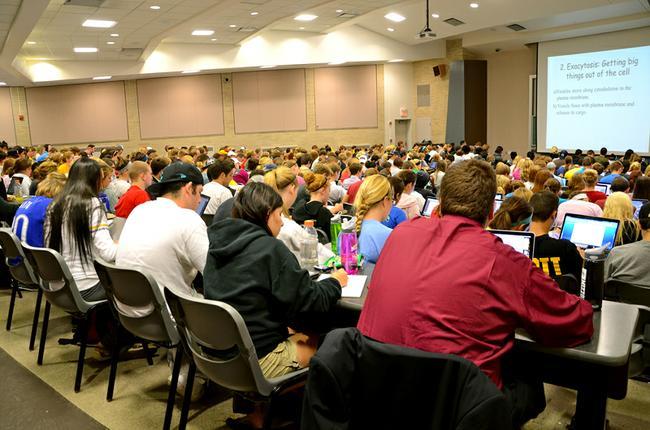Using guidelines set by the National Center for Academic Transformation as an outline, MU is redesigning the ways large lecture classes are taught to improve student learning.
In the next two years, the MU redesign will change the way Statistics 1200, Math 1300, Biology 1010, Human Development and Family Studies 2400, Nursing 2000 and Journalism 2150 are taught significantly.
“We’re looking at what we teach, how we teach it and how we evaluate it,” Vice Provost for Undergraduate Studies Jim Spain said.
According to NCAT’s website, the organization helps colleges and universities create and construct programs which use technology to reduce costs and analyzes the results of the programs to find specific techniques and practices that have the greatest impact on teaching and learning.
“NCAT works with institutions, systems, districts and states to scale the proof of concept to impact greater numbers of students, faculty members and institutions and achieve significant educational change,” the website stated.
MU hopes to implement similar changes in its class structures.
“We’re first going back through and identifying key learning tools, how effective the outcomes are and ways we have the course structured to accomplish that,” Spain said.
Course redesign is not unfamiliar, Associate Director of Educational Technology Margaret Gunderson said. For the past decade MU has used similar techniques under Educational Technologies at Missouri’s academic transformation initiative.
The requirements for ET@MO’s academic transformation were more lenient than MU’s redesign effort and wasn’t specific to large lecture courses. Academic transformation also didn’t focus on the analysis aspect as heavily as the redesign did.
“It had a similar pattern of support,” Gunderson said. “It did much less though and was a way to help get people started restructuring courses.”
It is helpful that some faculty members know what to expect with the redesign initiative, she added.
“The faculty members are the team leaders,” Gunderson said. “We have fantastic instructors on campus who care a lot about students and hope to help them with learning.”
The overall goal of both restructuring efforts is to help students learn.
“Student-centered learning is the primary focus and helping students learn more efficiently and effectively is the number one goal (of course redesign),” Gunderson said. “Also, it’s looking to help instructors be more effective and efficient with their teaching. In both ways student learning equals the priority.”
All classes are adopting technology as part of the redesign, but each course has different needs to fulfill, Gunderson said.
“Some classes were asked to expand quickly to include more students and have the course scaled to a bigger group,” she said. “Others are to create new modules and use content out there to make concepts apply to everyday life.”
Other classes, such as Statistics 1200, will restructure discussion sections to facilitate learning. Instructors of Biology 1010 also agreed to be a part of a statewide grant where they will share teaching modules with other biology departments across the state, Gunderson said.
“All the projects are in their beginning stages,” she said. “It’s a very exciting time.”
**Correction appended**
The original version of this story said there were five classes undergoing the changes – there are actually six. The article neglected to include Math 1300. Also, one of the final paragraphs should read “Other classes, such as Statistics 1200, will restructure discussion sections to facilitate learning. Instructors of Biology 1010 also agreed to be a part of a statewide grant where they will share teaching modules with other biology departments across the state, Gunderson said.” as opposed to what ran.








